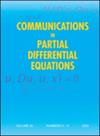逻辑扩散方程总种群规模的优化:bang-bang性质和碎片率
IF 1.7
2区 数学
Q1 MATHEMATICS
Communications in Partial Differential Equations
Pub Date : 2021-05-21
DOI:10.1080/03605302.2021.2007533
引用次数: 16
摘要
摘要在本文中,我们深入分析了标准逻辑扩散模型的总人口规模优化问题。这个优化问题源于空间生态学的研究,相当于以下问题:假设一个物种在一个领域中进化,为了确保平衡时的最大种群规模,传播资源的最佳方式是什么?近年来,许多作者对这一主题做出了贡献。我们在这里解决了优化器的两个基本性质的证明:一个是迄今为止只在几个强有力的假设下证明的“砰”的一个,另一个是最大化器的碎片化。我们用一种新的谱方法证明了bang-bang性质的普遍性。为证明优化器的bang-bang特性而引入的技术可以适用于许多优化问题,并推广到状态方程为双线性和椭圆的其他类双线性最优控制问题。我们在结论部分对此发表评论。关于最大化器的几何结构,当扩散率变小时,我们展示了最大化器BV范数的爆破率:如果是正交的,如果是最优控制,那么这个结果的证明依赖于一个非常精细的能量论点。本文章由计算机程序翻译,如有差异,请以英文原文为准。
Optimisation of the total population size for logistic diffusive equations: bang-bang property and fragmentation rate
Abstract In this article, we give an in-depth analysis of the problem of optimising the total population size for a standard logistic-diffusive model. This optimisation problem stems from the study of spatial ecology and amounts to the following question: assuming a species evolves in a domain, what is the best way to spread resources in order to ensure a maximal population size at equilibrium? In recent years, many authors contributed to this topic. We settle here the proof of two fundamental properties of optimisers: the bang-bang one, which had so far only been proved under several strong assumptions, and the other one is the fragmentation of maximisers. We prove the bang-bang property in all generality using a new spectral method. The technique introduced to demonstrate the bang-bang character of optimisers can be adapted and generalised to many optimisation problems with other classes of bilinear optimal control problems where the state equation is semilinear and elliptic. We comment on it in a conclusion section. Regarding the geometry of maximisers, we exhibit a blow-up rate for the BV-norm of maximisers as the diffusivity gets smaller: if is an orthotope and if is an optimal control, then The proof of this results relies on a very fine energy argument.
求助全文
通过发布文献求助,成功后即可免费获取论文全文。
去求助
来源期刊
CiteScore
3.60
自引率
0.00%
发文量
43
审稿时长
6-12 weeks
期刊介绍:
This journal aims to publish high quality papers concerning any theoretical aspect of partial differential equations, as well as its applications to other areas of mathematics. Suitability of any paper is at the discretion of the editors. We seek to present the most significant advances in this central field to a wide readership which includes researchers and graduate students in mathematics and the more mathematical aspects of physics and engineering.

 求助内容:
求助内容: 应助结果提醒方式:
应助结果提醒方式:


